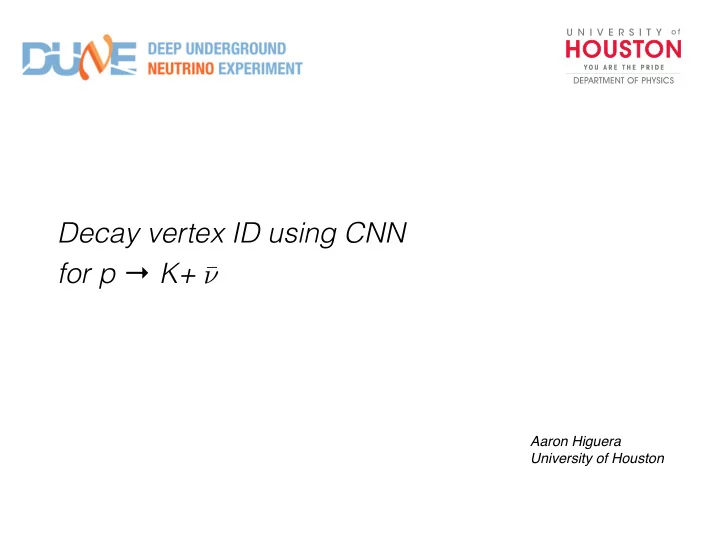

Decay vertex ID using CNN for p → K+ ¯ ν Aaron Higuera University of Houston
CNN Tools on the Proton Decay Analysis e + Standard vertex reconstruction use p → K+ ⊽ pmtracks in order to reconstruct a µ + vertex K + Ideally we would expect three two decay vertices K → µ Proton decay occurs at the nucleus Standard vertex reco only FS particles are detectable in the TPC (as in G4 simulation) 2
CNN Tools on the Proton Decay Analysis p → K+ ⊽ Proton decay simulation → µ + +v µ → e + +v e e + Time µ + K Time 3
CNN Tools on the Proton Decay Analysis Classify the central pixel target class [decay] Previous model was trained using target class[had_int decay γ Conv] 4
CNN Tools on the Proton Decay Analysis target class background (random point) 5
CNN target input (decay vertex) background (random point) convolutional layers GPUs dense layers Model 6
CNN Tools on the Proton Decay Analysis Dump all hits of each track, then use the CNN model to predict hit w/vertex, select candidates above a pointID threshold then look for coincidence with space points and create a vertex p → K+ ⊽ hits w/ predicted vertex e + µ + K + 7
CNN Tools on the Proton Decay Analysis is this better than standard reco? For Kaons For Muons 0.2 0.2 Arbitrary Units Arbitray Units Using CNN decay vertex Using CNN decay vertex 0.15 0.15 Using end of the track Using end of the track 0.1 0.1 0.05 0.05 0 0 0.5 1 1.5 2 2.5 3 3.5 4 0 0.5 1 1.5 2 2.5 3 3.5 4 distance to true decay vertex (cm) distance to true decay vertex (cm) 8
CNN Tools on the Proton Decay Analysis How many vertices do we find? Efficiency for events with K → µ+ ⊽ Events with kaon & muon track (based PIDA) New model Old model target class [decay] target class [had_int, decay, γ conv 9
CNN Tools on the Proton Decay Analysis The challenges Zoom In K + K + µ + K + K + heavy ionization hit accidentally selected as decay vtx K =106 MeV (KE) 10
CNN Tools on the Proton Decay Analysis There is a selection threshold K + µ + e + K =41 MeV (KE) p =23 MeV (KE) The model is blind to any decay that comes from kaons with KE below 50 MeV This is to avoid decay coming from nothing (particles with one or two hits) 11
CNN Tools on the Proton Decay Analysis 2 decay vertices examples K + µ + K + µ + µ + K + 12
Comments ✤ Results keep improving ✤ More improvements are needed ✤ Vertex and track associations ✤ Suggestion? 13
The End 14
Workflow 1) Generate your sample background and signal 2) Dump the ADC info for further processing and training Output- This would produce adc map synced with pdg map 3) Prepare data input: patch ~20x20cm of deconvoluted ADC output: vector of 3 values: [had_int decay pi0decay(gammaConv)] 4) Training your model GPU machine, thanks to Center for Advance Computing & Data Systems UH 5) Dump Keras model into a pure C++ model 6) Run ParticleDecayId_module.cc Uses hits and spacepoints from track with CNN info to produces vertices 15
Recommend
More recommend